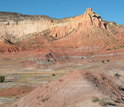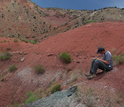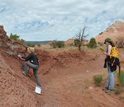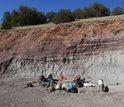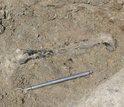News Release 15-067
Big dinosaurs steered clear of the tropics
Climate swings lasting millions of years too much for dinos
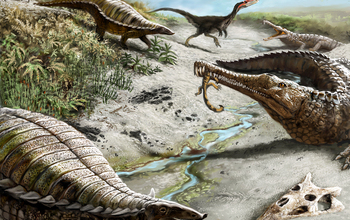
Some 212 million years ago, landscapes weren't all dinosaur-friendly: dry, hot, with wildfires.
June 15, 2015
This material is available primarily for archival purposes. Telephone numbers or other contact information may be out of date; please see current contact information at media contacts.
For more than 30 million years after dinosaurs first appeared, they remained inexplicably rare near the equator, where only a few small-bodied meat-eating dinosaurs made a living.
The long absence at low latitudes has been one of the great, unanswered questions about the rise of the dinosaurs.
Now the mystery has a solution, according to scientists who pieced together a detailed picture of the climate and ecology more than 200 million years ago at Ghost Ranch in northern New Mexico, a site rich with fossils.
The findings, reported today in the journal Proceedings of the National Academy of Sciences (PNAS), show that the tropical climate swung wildly with extremes of drought and intense heat.
Wildfires swept the landscape during arid regimes and reshaped the vegetation available for plant-eating animals.
"Our data suggest it was not a fun place," says scientist Randall Irmis of the University of Utah.
"It was a time of climate extremes that went back and forth unpredictably. Large, warm-blooded dinosaurian herbivores weren't able to exist close to the equator--there was not enough dependable plant food."
The study, led by geochemist Jessica Whiteside, now of the University of Southampton, is the first to provide a detailed look at climate and ecology during the emergence of the dinosaurs.
Atmospheric carbon dioxide levels then were four to six times current levels. "If we continue along our present course, similar conditions in a high-CO2 world may develop, and suppress low-latitude ecosystems," Irmis says.
"These scientists have developed a new explanation for the perplexing near-absence of dinosaurs in late Triassic [the Triassic was between 252 million and 201 million years ago] equatorial settings," says Rich Lane, program director in the National Science Foundation's (NSF) Division of Earth Sciences, which funded the research.
"That includes rapid vegetation changes related to climate fluctuations between arid and moist climates and the resulting extensive wildfires of the time."
Reconstructing the deep past
The earliest known dinosaur fossils, found in Argentina, date from around 230 million years ago.
Within 15 million years, species with different diets and body sizes had evolved and were abundant except in tropical latitudes. There the only dinosaurs were small carnivores. The pattern persisted for 30 million years after the first dinosaurs appeared.
The scientists focused on Chinle Formation rocks, which were deposited by rivers and streams between 205 and 215 million years ago at Ghost Ranch (perhaps better known as the place where artist Georgia O'Keeffe lived and painted for much of her career).
The multi-colored rocks of the Chinle Formation are a common sight on the Colorado Plateau at places such as the Painted Desert at Petrified Forest National Park in Arizona.
In ancient times, North America and other land masses were bound together in the supercontinent Pangea. The Ghost Ranch site stood close to the equator, at roughly the same latitude as present-day southern India.
The researchers reconstructed the deep past by analyzing several kinds of data: from fossils, charcoal left by ancient wildfires, stable isotopes from organic matter, and carbonate nodules that formed in ancient soils.
Fossilized bones, pollen grains and fern spores revealed the types of animals and plants living at different times, marked by layers of sediment.
Dinosaurs remained rare among the fossils, accounting for less than 15 percent of vertebrate animal remains.
They were outnumbered in diversity, abundance and body size by reptiles known as pseudosuchian archosaurs, the lineage that gave rise to crocodiles and alligators.
The sparse dinosaurs consisted mostly of small, carnivorous theropods.
Big, long-necked dinosaurs, or sauropodomorphs--already the dominant plant-eaters at higher latitudes--did not exist at the study site nor any other low-latitude site in the Pangaea of that time, as far as the fossil record shows.
Abrupt changes in climate left a record in the abundance of different types of pollen and fern spores between sediment layers.
Fossilized organic matter from decaying plants provided another window on climate shifts. Changes in the ratio of stable isotopes of carbon in the organic matter bookmarked times when plant productivity declined during extended droughts.
Drought and fire
Wildfire temperatures varied drastically, the researchers found, consistent with a fluctuating environment in which the amount of combustible plant matter rose and fell over time.
The researchers estimated the intensity of wildfires using bits of charcoal recovered in sediment layers.
The overall picture is that of a climate punctuated by extreme shifts in precipitation and in which plant die-offs fueled hotter fires. That in turn killed more plants, damaged soils and increased erosion.
Atmospheric carbon dioxide levels, calculated from stable isotope analyses of soil carbonate and preserved organic matter, rose from about 1,200 parts per million (ppm) at the base of the section, to about 2,400 ppm near the top.
At these high CO2 concentrations, climate models predict more frequent and more extreme weather fluctuations consistent with the fossil and charcoal evidence.
Continuing shifts between extremes of dry and wet likely prevented the establishment of the dinosaur-dominated communities found in the fossil record at higher latitudes across South America, Europe, and southern Africa, where aridity and temperatures were less extreme and humidity was consistently higher.
Resource-limited conditions could not support a diverse community of fast-growing, warm-blooded, large dinosaurs, which require a productive and stable environment to thrive.
"The conditions would have been something similar to the arid western United States today, although there would have been trees and smaller plants near streams and rivers, and forests during humid times," says Whiteside.
"The fluctuating and harsh climate with widespread wildfires meant that only small two-legged carnivorous dinosaurs could survive."
-NSF-
-
The multi-colored slope-forming rocks of the Chinle Formation at Ghost Ranch, New Mexico.
Credit and Larger Version -
Scientist Randall Irmis taking notes, and rock samples for extraction of pollen and spores.
Credit and Larger Version -
Geoscientists Jessica Whiteside and Maria Dunlavey taking rock samples at Ghost Ranch.
Credit and Larger Version -
Looking back millions of years: Crews excavating fossils from Hayden Quarry at Ghost Ranch.
Credit and Larger Version -
A 212-million-year-old leg bone of a small, uncommon early carnivorous dinosaur encased in rock.
Credit and Larger Version
Media Contacts
Cheryl Dybas, NSF, (703) 292-7734, email: cdybas@nsf.gov
Joe Rojas-Burke, University of Utah, (801) 585-6861, email: joe.rojas@utah.edu
Related Websites
NSF Grant: Collaborative Research: An Exceptional Window into Late Triassic Terrestrial Ecosystems from the Western United States: http://www.nsf.gov/awardsearch/showAward?AWD_ID=1349650&HistoricalAwards=false
The U.S. National Science Foundation propels the nation forward by advancing fundamental research in all fields of science and engineering. NSF supports research and people by providing facilities, instruments and funding to support their ingenuity and sustain the U.S. as a global leader in research and innovation. With a fiscal year 2023 budget of $9.5 billion, NSF funds reach all 50 states through grants to nearly 2,000 colleges, universities and institutions. Each year, NSF receives more than 40,000 competitive proposals and makes about 11,000 new awards. Those awards include support for cooperative research with industry, Arctic and Antarctic research and operations, and U.S. participation in international scientific efforts.
Connect with us online
NSF website: nsf.gov
NSF News: nsf.gov/news
For News Media: nsf.gov/news/newsroom
Statistics: nsf.gov/statistics/
Awards database: nsf.gov/awardsearch/
Follow us on social
Twitter: twitter.com/NSF
Facebook: facebook.com/US.NSF
Instagram: instagram.com/nsfgov



